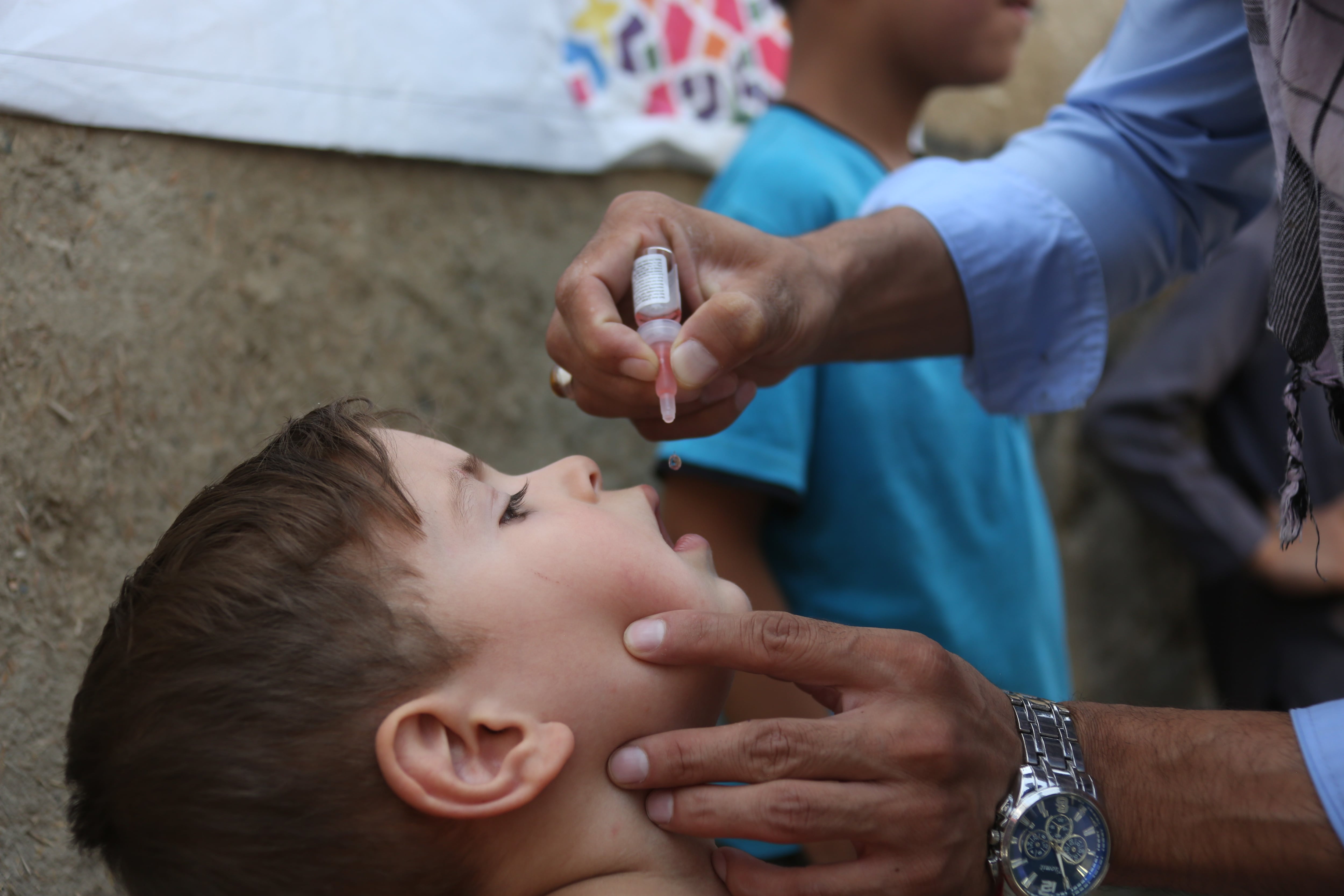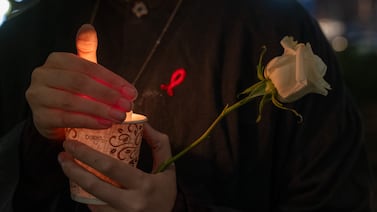Public health, explained: Sign up to receive Healthbeat’s Global Checkup in your inbox a day early.
Hello from Nairobi.
Winter may be coming elsewhere ... but certainly not here! I’m nursing a sunburn from a warm weekend getaway and a long swim in a spring-fed river with my toddler. (She’s fine; I dipped her in sunscreen like a SPF-50 Achilles.)
This week’s report brings a few stories that buck the fear that, as the tide of global health financing recedes, we’re headed for the worst possible outcomes. Still, if you think I’m missing the takeaway, or just spotted a story I should have, let me know: wherkewitz@healthbeat.org.
My name is William Herkewitz, and I’m a journalist based in Nairobi, Kenya. This is the Global Health Checkup, where I highlight five of the week’s most important stories on outbreaks, medicine, science, and survival from around the world.
With that, as we say in Swahili: karibu katika habari — welcome to the news.
Polio vs. the clock
There’s big news in the decades-long fight to wipe polio from the planet. First the bad: the Global Polio Eradication Initiative’s budget is shrinking by 30% starting next year, purely due to global health budgets tightening. All told, that’s a $1.7 billion shortfall through 2029.
The good news? Officials say the cuts aren’t a death knell. Global elimination remains in sight, even if it will take longer to reach, Reuters reports.
- Disease breakdown: Polio, or poliomyelitis, is a gut virus that spreads largely through feces. While most infections pass without symptoms, the worst cases can wither limbs or invade the spinal cord to cause paralysis or death. Importantly, the disease can’t hide in animals, and vaccines stop it cold. That’s why although polio is ancient enough to have been carved into Egyptian hieroglyphs, today we are on the verge of its eradication. In fact, two strains of the virus were eliminated in 1999 and 2020, and only two more remain.
I reached out to Steven Lauwerier, director of UNICEF’s polio eradication team (note: UNICEF works under the World Health Organization on the global effort) to understand how to digest this news.
First, while “the cuts are serious,” Lauwerier says, he makes it clear that the new game plan isn’t just kicking the deadline down the road. The Global Polio Eradication Initiative is taking a genuine effort to do more with less: to squeeze out inefficiencies in existing programs, stretch out vaccine supplies with smaller doses, merge vaccination drives with other programs like Gavi, and refocus on the few places where the virus still hides. (My take, not Lauwerier’s: Anyone who’s worked with the bureaucratic shoggoth that is the WHO knows that there are efficiencies out there to be claimed, so it’s excellent that the polio campaign is taking the challenge so seriously.)
As for timing, the last wild strain of the virus (still hanging on in Afghanistan and Pakistan) is now expected to be stopped by 2027, a year later than planned. Meanwhile a strain of the virus that bubbled up from earlier vaccine drives, and which is largely pocketed across the African continent, now has a new 2029 target.
Lauwerier notes that one of the biggest challenges is the “wild polio virus in Afghanistan, where we are not allowed to do house-to-house campaigns,” he says. That’s because of a ban under Taliban rule, which is a lingering consequence of the CIA’s 2011 fake polio vaccine plot to find Osama bin Laden in neighboring Pakistan.
Still, Lauwerier reminds me that the initiative has “had bigger challenges in the past and [has] shown that we can overcome them.” He notes incredible progress fighting polio in the Democratic Republic of the Congo, Madagascar, and hard to reach communities across south eastern Africa. “If we can do it there, we can do it everywhere.”
The heartening takeaway? “Eradication is still fully achievable,” he says. “We will go full speed until we reach interruption everywhere.”
Bird flu, big in Europe
Bird flu is sweeping across Europe. Outbreaks have hit 10 European Union countries plus Britain since August, including major poultry producers Poland, Spain, and Germany. It’s the widest early spread of this disease in a decade.
- Disease breakdown: Bird flu is a cousin of human influenza, also known as H5N1. (The H and N numbers refer to the shape of two important proteins on the outside of the virus.) Bird flu spreads largely through bird droppings and is usually fatal in poultry. It usually peaks in autumn and winter in the Northern Hemisphere because that’s when migratory birds carrying the virus arrive along ancient flyways from the Arctic to Africa. The virus mostly stays bird-bound, with crowded poultry farms especially vulnerable. (They are proverbially, and sometimes literally, sitting ducks.) The virus will also occasionally jump to mammals, including humans.
Nowhere is the alarm louder than in Germany. Daily Finland reports that bird flu has been confirmed in wild birds across all but one of 16 German states. According to the article, “more than 200,000 chickens, geese, ducks, and turkeys have been culled … in order to contain the spread of the disease.” While this is still just a 10th of the culling that happened during the worst-ever 2020 outbreak, German Agriculture Minister Alois Rainer noted, “This is not unusual for this time of year.”
And the outbreaks are not just in Europe. Healthbeat Atlanta reports the state of Georgia has confirmed its fifth outbreak this year. And the New York Times reports elsewhere across the United States — where “the virus has affected more than 180 million farmed birds” since 2022 — cases are likewise surging. Worse still, so far “three states … have identified outbreaks in dairy cows.”
What’s the takeaway? Bird flu used to largely be a winter problem. Now it’s showing up earlier each year and in more species, slowly blurring the line between outbreaks from wild flocks and commercial farms. And while the virus hasn’t yet evolved to spread between humans, that leap remains one of the biggest worries for the next pandemic.
A 20/20 future for Fiji
The World Health Organization has officially declared Fiji free of trachoma, which is the leading infectious cause of blindness, Fiji’s Islands Business reports. It’s a victory decades in the making that relied on a long chain of partnerships, including between local nongovernmental organizations like Project Heaven and international efforts such as the former U.S. Agency for International Development-funded Global Trachoma Mapping Project.
- Disease breakdown: Trachoma is an infection caused by the chlamydia trachomatis bacteria. It spreads through direct contact with eye and nose discharge, and largely in places with poor water and sanitation. It’s found in 31 countries and is responsible for blindness or visual impairment in about 1.9 million people. That’s because repeated infections scar the eyelid until lashes turn inward and scrape the eye.
Why does eliminating one disease on one tiny island country make the cut this week? (... Other than my desperate attempt to sneak in some good news in a field that, let’s face it, can often be a bit of a bummer.)
Fiji’s trachoma victory, like the progress on polio, is a reminder that international funding and global commitments can be rolling back even as dedicated heroes refuse to let that stop them. Both stories are long-tail wins born of decades of patient coordination and community work. They’re also proof that the systems built by the old global health order are still out there, saving lives.
Following Senegal’s Rift Valley Fever fight
We’ve been following Senegal’s worst outbreak in decades of Rift Valley Fever. Since my last update on Oct. 16, reported cases have more than doubled, and the government has rolled out a nationwide campaign, SciDev.net reports. (A reminder: Rift Valley Fever is largely a mosquito-borne livestock disease, which occasionally spills over into humans, as it’s doing now.) This outbreak is slowly building to what we expected it might become, as I wrote, “a test of how well these national and regional health systems can respond during the global health funding crunch.”
Senegal is taking this extremely seriously. The nationwide campaign has brought “together ministries of health, agriculture, environment, and water resources,” to conduct disease surveillance, mosquito control, livestock vaccination, and a public advisory campaign in various local languages. (Senegal is home to more than 30 languages and dialects.)
I have lots of questions: I’m curious about funding, about the efficacy of this coordinated push, and about what happens beyond Senegal’s borders. Remember, the outbreak cuts through a livestock corridor shared with Mauritania and Mali, which are behind Senegal in development and their outbreak response capacity. Will those countries match Senegal’s urgency, and will international organizations step in to help?
We’ll follow up once there’s concrete evidence on how this all plays out.
The high cost of cutting malaria aid
Last week we covered a bit of political drama on fundraising for The Global Fund, which is the massive organization that collects donations from wealthy governments and funnels them into programs that fight AIDS, tuberculosis, and malaria. Over the weekend, a new analysis put hard numbers on what those shortfalls might actually mean, The Guardian reports.
According to researchers from the inter-governmental body the African Leaders Malaria Alliance and the nonprofit Malaria No More, a 20% funding cut to the Global Fund could lead to 33 million extra malaria cases, 82,000 malaria deaths, and roughly $5 billion in lost GDP across sub-Saharan Africa by 2030. This effect is particularly severe because The Global Fund “provides nearly 60% of all international financing for malaria controls, such as mosquito nets and preventive drugs.”
The researchers also modeled a total funding collapse scenario, and the toll would be staggering:
“The report estimates there would be 525 million more cases, 990,000 more deaths, and $83 billion in lost GDP. About 750,000 of those deaths would be of children under 5, representing ‘the loss of a generation to malaria’, the report’s authors warned.”
To be clear, there is zero reporting that an apocalyptic collapse in malaria funding is coming. Heck, I’m going on record: It’s not coming. But as countries start to turn down their pledges (the UK is rumored to be considering a 20% cut) this report makes clear the stakes. We’ll follow up at the end of November, when The Global Fund’s public pledging conference wraps up to see where we’ve landed.
See you next week!
William Herkewitz is a reporter covering global public health for Healthbeat. He is based in Nairobi. Contact William at wherkewitz@healthbeat.org.







